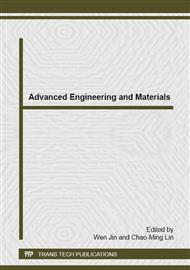[1]
C.M. Reddy, R. S Gaston, C.M. Weikart and H.K. Yasuda: Influence of surface pretreatment and electrocoating parameters on the adhesion of cathodic electrocoat to the Al alloy surfaces, (The University of Missouri 1998).
DOI: 10.1016/s0300-9440(98)00068-x
Google Scholar
[2]
M. Bayramoglu, B. Onat and N. Geren: Statistical optimization of process parameters to obtain maximum thickness and brightness in chromium plating, (The University of Cukurova, Adana, Turkey 2007).
DOI: 10.1016/j.jmatprotec.2007.09.063
Google Scholar
[3]
M.S. Raisinghani, H. Ette and R. Pierce: Six Sigma concepts, tools, and application, Industrial Management & Data System, Vol. 105 (2005), pp.491-505.
DOI: 10.1108/02635570510592389
Google Scholar
[4]
J. Antony, M. Kumar, and M.K. Tiwari: An application of Six Sigma methodology to reduce the engine overheating problem in an automotive company, Journal of Engineering Manufacture, Vol. 209 (2005), pp.633-646.
DOI: 10.1243/095440505x32418
Google Scholar
[5]
R.B. Anand, S.K. Shukla, A. Ghorpade, M.K. Tiwari and R. Shankare: Six Sigma-based approach to optimize deep drawing operation variables, International Journal of Production Research, Vol. 45 (2007), pp.2365-2385.
DOI: 10.1080/00207540600702308
Google Scholar
[6]
W. L. Xie, S. Y. Zhou, and Y. Hu: Parameters Optimization for Injection Molding Based on Digital Signal Processing, Applied Mechanics and Materials, Vol. 433-435 (2013), pp.1890-1893.
DOI: 10.4028/www.scientific.net/amm.433-435.1890
Google Scholar
[7]
Y. Wu, W. Wu, and J. Ruan: The optimization analysis of the conditions for optimal parameter combination of husker capacity by response surface method, Applied Mechanics and Materials, Vol. 433-435 (2013), pp.2203-2207.
DOI: 10.4028/www.scientific.net/amm.433-435.2203
Google Scholar
[8]
P. Ruthaiputpong and N. Rojanarowan: Improvement of track zero to increase read/write area in hard disk drive assembly process, Uncertain Supply Chain Management (2013), pp.165-176.
Google Scholar
[9]
S. Suthongchai and N. Rojanarowan: The use of the Six sigma approach to minimize the defective rate from bending defects in harddisk drive, Advanced Materials Research, Vol. 974 (2014), pp.298-304.
DOI: 10.4028/www.scientific.net/amr.974.298
Google Scholar
[10]
W. Sonphuak and N. Rojanarowan: Strength improvement of fibre cement product, International Journal of Industrial Engineering Computations (2013), pp.505-516.
DOI: 10.5267/j.ijiec.2013.06.004
Google Scholar
[11]
N. Rojanarowan and T. Senprom: Glass-Mold Defective Reduction in Plastic Lenses Manufacturing Process Using Six Sigma Approach, Advanced Materials Research, Vols. 156-157 (2011) pp.1598-1602.
DOI: 10.4028/www.scientific.net/amr.156-157.1598
Google Scholar
[12]
C. Wu and H. Kuo: Sample Size Determination for the Estimate of Process Capability Indices, Information and Management Sciences, Vol. 15 (2004), pp.1-12.
Google Scholar
[13]
S. Kotz and C.R. Lovelace: Process Capability Indices in Theory and Practice. New York, Arnold, (1998).
Google Scholar
[14]
Y. Fasser and D. Brettner: Process Improvement in the Electronic Industry. 1st ed., J. New York: Wiley & Sons, Inc, (1992).
Google Scholar
[15]
A.I.A. Group: Measurement Systems Analysis, Reference Manual, Automotive Industry Action Group , 3 rd ed. Michigan, (2002).
Google Scholar
[16]
D.C. Montgomery, Applied Statistics and Probability for engineers. 5th ed. New York: John Wiley & Sons, Inc, (2011).
Google Scholar


